Locks With Leaves And Swelling Buds at Palazzo Cavanis in Venice
From April 20th to September 1st, 2024, the Palazzo Cavanis becomes the backdrop for Ewa Juszkiewicz’s solo exhibition, Locks With Leaves And Swelling Buds, held as an official collateral event of the Venice Art Biennale. Within the palazzo’s historic architecture, Juszkiewicz reimagines female representation in art through a series of captivating faceless oil portraits.
Combining both existing works and pieces crafted specifically for this Venice showcase, the exhibition unveils a collection of paintings reminiscent of 18th and 19th-century portraiture. Yet, instead of traditional facial features, Juszkiewicz employs surreal distortions: folds of fabric, floral arrangements, or elaborate hairstyles that obscure the subjects’ faces. In this way, the artist challenges notions of identity while also subverting the historical patriarchal gaze embedded in traditional women’s portraiture. By focusing on anti-faciality, Juszkiewicz blurs the boundaries between femininity and the implicit violence of masking, resulting in a series of enigmatic figures. ‘I believe it essential to address the domination of the male narrative and reclaim the place of women in history,’ the artist tells designboom. To find more about Locks With Leaves And Swelling Buds, and the concept behind it, read the interview in full below.
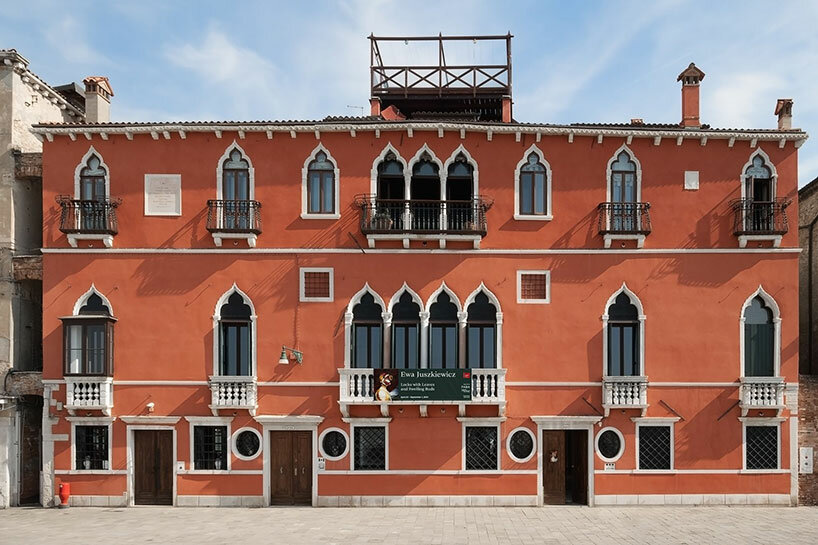
the exterior of Palazzo Cavanis, 2024 | photo by Eleonora Paciullo
interview with Ewa Juszkiewicz
designboom (DB): Can you tell us about your exhibition, Locks with Leaves and Swelling Buds, and how the idea for this collateral event for the Venice Biennale came about?
Ewa Juszkiewicz (EJ): The title of my exhibition Locks with Leaves and Swelling Buds, comes from an 18th-century poem. It’s a quote from Ode to Spring by Anna Laetitia Barbauld, a famous British poet. The show brings together 15 paintings, including 5 paintings that I created especially for the exhibition— with this beautiful, historic space in mind. When I visited Palazzo Cavanis in person for the first time, I was impressed not only by the frescoes, Murano glass chandeliers, and 18th-century marble ornaments but also by the wonderful natural light that fills all rooms. I immediately felt that it was the perfect space for my paintings, a space where history and modernity intertwine and remain in constant dialogue. The exhibition features a selection of my paintings from several series created since 2019.
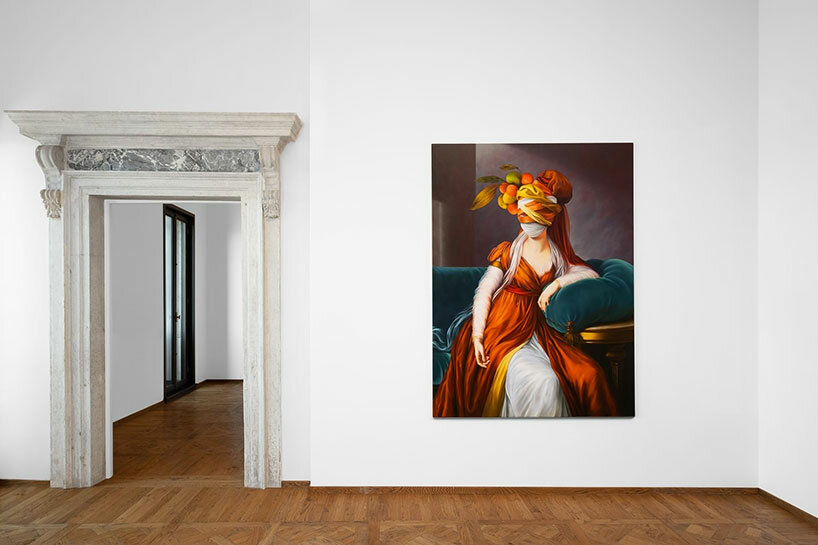
installation view of Ewa Juszkiewicz, Palazzo Cavanis, 2024 / © Ewa Juszkiewicz- courtesy of the artist and Almine Rech – photo: Eleonora Paciullo
DB: Your work often involves a transformation of traditional portraits of women from centuries past. What initially drew you to this subject matter, and how has your approach evolved over the years?
EJ: The history of portraiture has always fascinated me, even when I was a teenager. I have always loved traveling and spending time in museums, observing how portraiture has evolved over the centuries and how styles and aesthetics have changed. For me, European portrait painting, especially from the 18th and 19th centuries, is extremely attractive and alluring visually. When I look at paintings from this period, I am always amazed by their richness, colors, great technique, and unique aura. I also love fashion from that time— the clothes, hairstyles, accessories, and jewelry. However, while looking at representations of women from that period, it is difficult not to notice the common idealization in the presentation of female images. That there are repeated patterns and limitations inherent to them. The stereotypes present in these paintings made me feel the need to question them, to start a discussion with them. My work is a protest against conventional images of femininity, against idealizations, and traditional canons of female beauty.
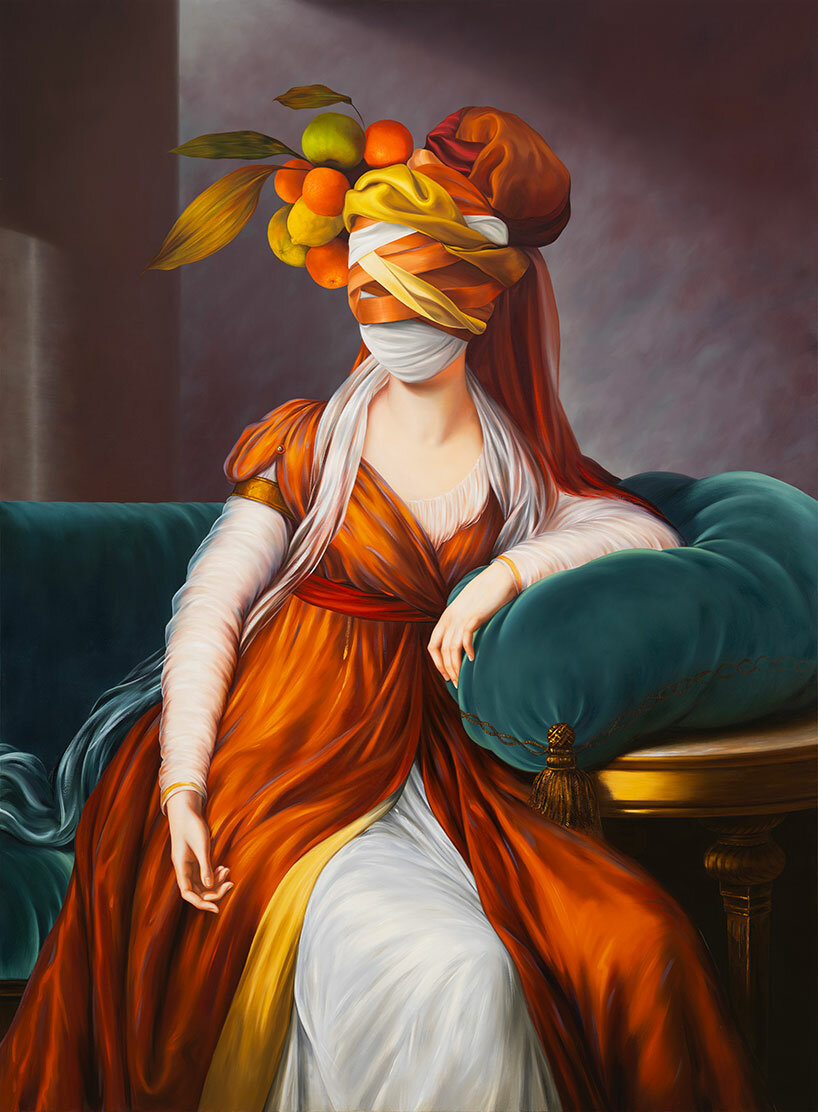
Ewa Juszkiewicz, Portrait in Venetian Red (after Élisabeth-Louise Vigée Le Brun), oil on canvas, 190 x 140 cm, 2024. Courtesy Ewa Juszkiewicz and Almine Rech.
DB: The use of masks is a recurring motif in your work. What inspired this exploration, and what do you aim to convey through these masks?
EJ: By modifying and transforming historical portraits, I want to disturb the harmony and aesthetic canons of a given period. I wish to break the uniform, conservative idea of beauty that paintings from the past often represent. My goal is to build my own, alternative narrative. Masks in my paintings are intended to release the individuality, expression, dynamism, and vitality that was hidden behind the layer of convention.
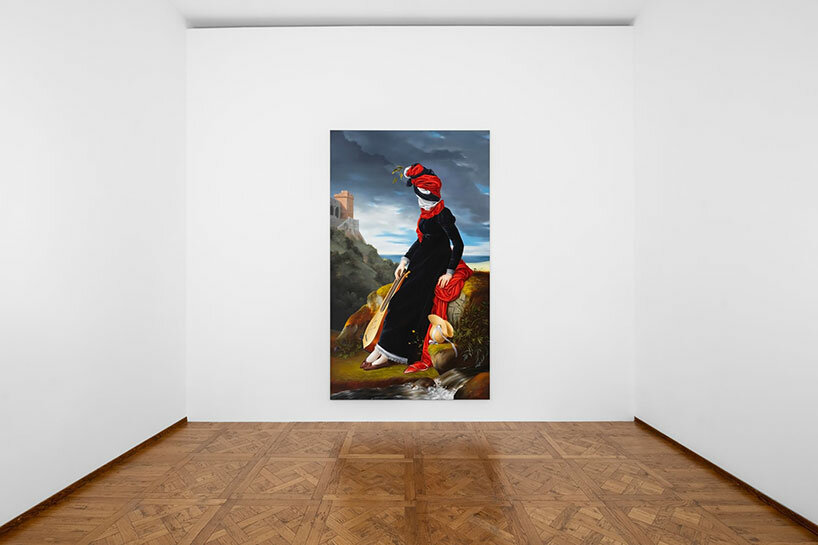
installation view of Ewa Juszkiewicz, Palazzo Cavanis, 2024 / © Ewa Juszkiewicz- courtesy of the artist and Almine Rech – photo: Eleonora Paciullo
DB: Your paintings often feature objects and materials that replace the traditional facial features of subjects, such as hypertrophied mushrooms or bouquets of flowers. Can you discuss the symbolism behind these choices?
EJ: In some of my paintings, I cover women’s portraits with fruits, plants, and draperies— traditional elements of still lifes. Fruits and fabrics in my paintings are usually theatrical and idealized, as are the portraits they obscure. Through these modifications, I challenge social expectations regarding the female image. The questions I ask myself as I work on these paintings are whether the main role of images of women was, and still is, to delight, to be an aesthetic object for the viewing pleasure of others? Is the role of representations of women still primarily decorative? Through covering female portraits with elements reminiscent of Dutch Golden Age still lifes, I also seek to shed light on the realities faced by female artists in the 17th and 18th centuries. Limited access to artistic education and the lack of opportunities to learn human anatomy forced many women to specialize in still life painting. As a result, many women artists became specialists in painting flowers and other botanical compositions.
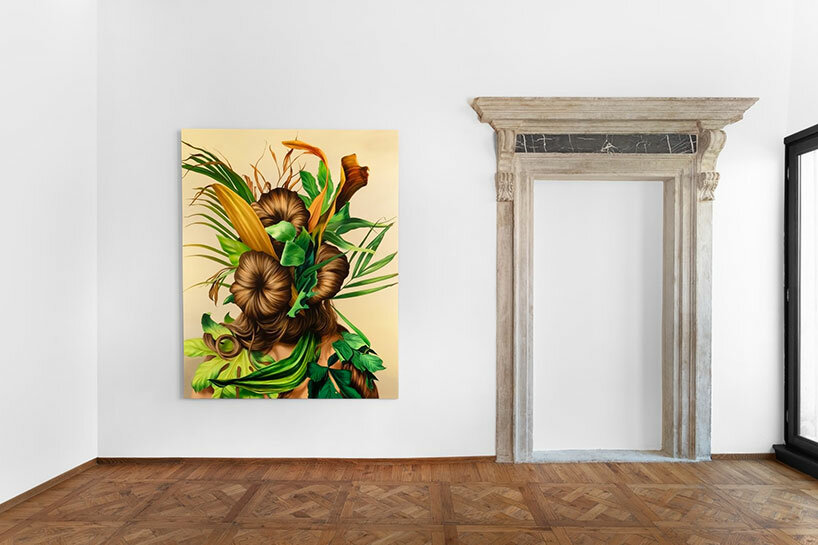
installation view of Ewa Juszkiewicz, Palazzo Cavanis, 2024 / © Ewa Juszkiewicz- courtesy of the artist and Almine Rech – photo: Eleonora Paciullo
DB: According to Guillermo Solana, curator of the exhibition, in your reinterpretation of historical portraits, you aim to challenge the patriarchal constructs embedded within the genre. Could you elaborate on how your paintings reflect and comment on the condition of women in society?
EJ: As we know, the role of women in history has often been marginalized. Over the centuries, women have experienced, and unfortunately still often experience, inequality. Their role, not only in art, but also in science or business, was marginalized. I believe it essential to address the domination of the male narrative and reclaim the place of women in history. Observing images of women in art across the centuries, it becomes clear that the way women are depicted is often significantly different from the way men are depicted. Especially in the 18th and 19th
centuries, women were often portrayed as passive and devoid of expression, in a theatrical and idealized way, according to the convention common at that time. In my work, I consciously enter into a dialogue with history, clichés, and canons that were present in the past. In this way, I want to revive old paintings and revise the viewer’s perception of what is well known and recognizable. Through my paintings, I seek to give new meaning to these well-known portraits, reclaiming the narrative of women and challenging stereotypical perceptions of femininity.
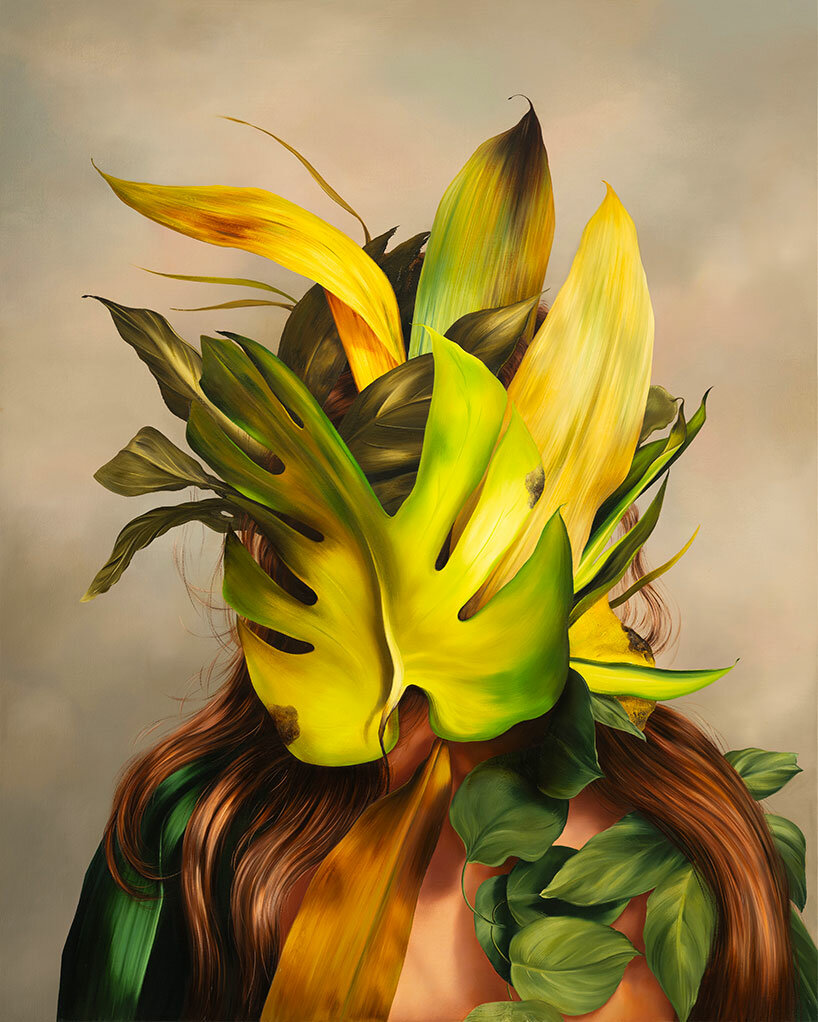
Ewa Juszkiewicz, Monstera, oil on canvas, 100 x 80 cm, 2024. courtesy Ewa Juszkiewicz and Almine Rech.

installation view of Ewa Juszkiewicz, Palazzo Cavanis, 2024 / © Ewa Juszkiewicz- courtesy of the artist and Almine Rech – photo: Eleonora Paciullo
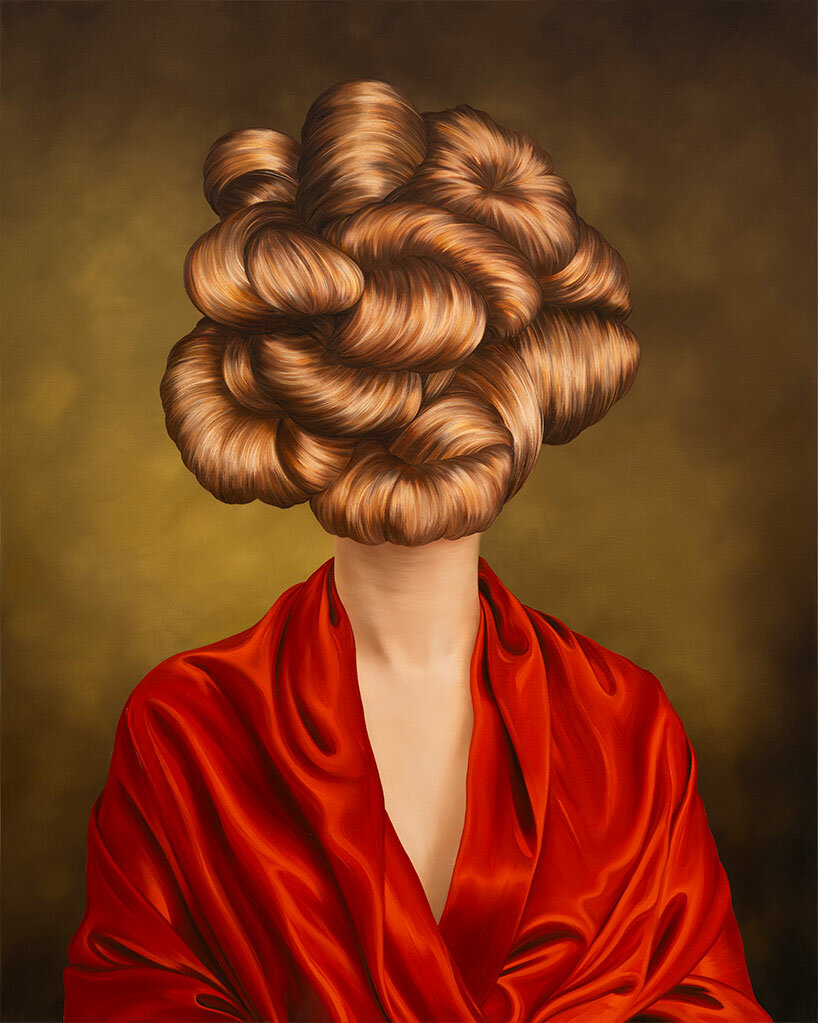
Ewa Juszkiewicz, Red Dress, oil on canvas, 100 x 80 cm, 2024. courtesy Ewa Juszkiewicz and Almine Rech.






